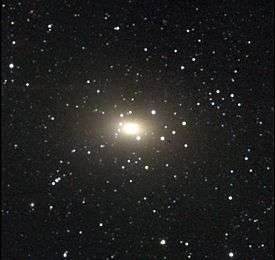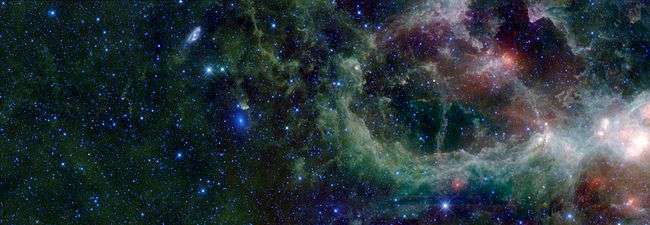IC 342/Maffei Group
| IC 342/Maffei Group | |
|---|---|
 | |
| Observation data (Epoch J2000) | |
| Constellation(s) | Cassiopeia/Camelopardalis/Perseus |
| Brightest member | IC 342[1] |
| Number of galaxies | 16[1] |
| Other designations | |
| IC 342 Group, Maffei 1 Group, LGG 104 | |
| See also: Galaxy groups, Galaxy clusters, List of galaxy clusters | |
The IC 342/Maffei Group (also known as the IC 342 Group or the Maffei 1 Group) is the nearest group of galaxies to the Local Group. The group can be described as a binary group; the member galaxies are mostly concentrated around either IC 342 or Maffei 1, both of which are the brightest galaxies within the group.[1] The group is part of the Virgo Supercluster.[2]
Members
The table below lists galaxies that have been identified as associated with the IC342/Maffei 1 Group by I. D. Karachentsev.[1] Note that Karachentsev divides this group into two subgroups centered around IC 342 and Maffei 1.
| Name | Type[3] | R.A. (J2000)[3] | Dec. (J2000)[3] | Redshift (km/s)[3] | Apparent Magnitude[3] |
|---|---|---|---|---|---|
| Camelopardalis A | Irr | 04h 26m 16.3s | +72° 48′ 21″ | -46 ± 1 | 14.8 |
| Camelopardalis B | Irr | 04h 53m 07.1s | +67° 05′ 57″ | 77 | 16.1 |
| Cassiopeia 1 | dIrr | 02h 06m 02.8s | +68° 59′ 59″ | 35 | 16.4 |
| IC 342 | SAB(rs)cd | 03h 46m 48.5s | +68° 05′ 46″ | 31 ± 3 | 9.1 |
| KK 35 | Irr | 03h 45m 12.6s | +67° 51′ 51″ | 105 ± 1 | 17.2 |
| NGC 1560 | SA(s)d | 04h 32m 49.1s | +71° 52′ 59″ | -36 ± 5 | 12.2 |
| NGC 1569 | Sbrst | 04h 30m 49.1s | +64° 50′ 52,6″ | -104 ± 4 | 11,2 |
| UGCA 86 | Im | 03h 59m 50.5s | +67° 08′ 37″ | 67 ± 4 | 13.5 |
| UGCA 92 | Im | 04h 32m 04.9s | +63° 36′ 49.0″ | -99 ± 5 | 13.8 |
| UGCA 105 | Im | 05h 14m 15.3s | +62° 34′ 48″ | 111 ± 5 | 13.9 |
| Name | Type[3] | R.A. (J2000)[3] | Dec. (J2000)[3] | Redshift (km/s)[3] | Apparent Magnitude[3] |
|---|---|---|---|---|---|
| Dwingeloo 1 | SB(s)cd | 02h 56m 51.9s | +58° 54′ 42″ | 110 | 8.3 |
| Dwingeloo 2 | Im | 02h 54m 08.5s | +59° 00′ 19″ | 94 ± 1 | 20.5 |
| KKH 11 | dE | 02h 24m 34.2s | +56° 00′ 43″ | 310 | 16.2 |
| KKH 12 | Irr | 02h 27m 26.9s | +57° 29′ 16″ | 70 | 17.8 |
| Maffei 1 | S0 pec | 02h 36m 35.4s | +59° 39′ 19″ | 13 ± 22 | 11.4 |
| Maffei 2 | SAB(rs)bc | 02h 41m 55.1s | +59° 36′ 15″ | -17 ± 5 | 16.0 |
| MB 1 | SAB(s)d | 02h 35m 36.5s | +59° 22′ 43″ | 190 ± 1 | 20.5 |
| MB 3 | dSph | 02h 55m 42.7s | +58° 51′ 37″ | 59 ± 1 | 17.33 |
Additionally, KKH 37 is listed as possibly being a member of the IC 342 Subgroup, and KKH 6 is listed as possibly being a member of the Maffei 1 Subgroup.[1]

Foreground dust obscuration
As seen from Earth, the group lies near the plane of the Milky Way (a region sometimes called the Zone of Avoidance). Consequently, the light from many of the galaxies is severely affected by dust obscuration within the Milky Way. This complicates observational studies of the group, as uncertainties in the dust obscuration also affect measurements of the galaxies' luminosities and distances as well as other related quantities.[1][4]
Moreover, the galaxies within the group have historically been difficult to identify. Many galaxies have only been discovered using late 20th century astronomical instrumentation. For example, while many fainter, more distant galaxies, such as the galaxies in the New General Catalogue, were already identified visually by the end of the nineteenth century, Maffei 1 and Maffei 2 were only discovered in 1968 using infrared photographic images of the region.[5] Furthermore, it is difficult to determine whether some objects near IC 342 or Maffei 1 are galaxies associated with the IC 342/Maffei Group or diffuse foreground objects within the Milky Way that merely look like galaxies. For example, the objects MB 2 and Camelopardalis C were once thought to be dwarf galaxies in the IC 342/Maffei Group but are now known to be objects within the Milky Way.[6]
Group formation and possible interactions with the Local Group
Since the IC 342/Maffei Group and the Local Group are located physically close to each other, the two groups may have influenced each other's evolution during the early stages of galaxy formation. An analysis of the velocities and distances to the IC 342/Maffei Group as measured by M. J. Valtonen and collaborators suggested that IC 342 and Maffei 1 were moving faster than what could be accounted for in the expansion of the universe. They therefore suggested that IC 342 and Maffei 1 were ejected from the Local Group after a violent gravitational interaction with the Andromeda Galaxy during the early stages of the formation of the two groups.[7]
However, this interpretation is dependent on the distances measured to the galaxies in the group, which in turn is dependent on accurately measuring the degree to which interstellar dust in the Milky Way obscures the group.[4][8] More recent observations have demonstrated that the dust obscuration may have been previously overestimated, so the distances may have been underestimated. If these new distance measurements are correct, then the galaxies in the IC 342/Maffei Group appear to be moving at the rate expected from the expansion of the universe, and the scenario of a collision between the IC 342/Maffei Group and the Local Group would be implausible.[8]
References
- 1 2 3 4 5 6 I. D. Karachentsev (2005). "The Local Group and Other Neighboring Galaxy Groups". Astronomical Journal. 129 (1): 178–188. arXiv:astro-ph/0410065
 . Bibcode:2005AJ....129..178K. doi:10.1086/426368.
. Bibcode:2005AJ....129..178K. doi:10.1086/426368. - ↑ R. B. Tully (1982). "The Local Supercluster". Astrophysical Journal. 257: 389–422. Bibcode:1982ApJ...257..389T. doi:10.1086/159999.
- 1 2 3 4 5 6 7 8 9 10 "NASA/IPAC Extragalactic Database". Results for various galaxies. Retrieved 2006-12-30.
- 1 2 R. J. Buta; M. L. McCall (1999). "The IC 342/Maffei Group Revealed". Astrophysical Journal Supplement Series. 124 (1): 33–93. Bibcode:1999ApJS..124...33B. doi:10.1086/313255.
- ↑ P. Maffei (1968). "Infrared Object in the Region of IC 1895". Publications of the Astronomical Society of the Pacific. 80: 618–621. Bibcode:1968PASP...80..618M. doi:10.1086/128698.
- ↑ I. D. Karachentsev; M. E. Sharina; A. E. Dolphin; E. K. Grebel (2003). "Distances to nearby galaxies around IC 342". Astronomy and Astrophysics. 408 (1): 111–118. Bibcode:2003A&A...408..111K. doi:10.1051/0004-6361:20030912.
- ↑ M. J. Valtonen; G. G. Byrd; M. L. McCall; K. A. Innanen (1993). "A revised history of the Local Group and a generalized method of timing". Astronomical Journal. 105: 886–893. Bibcode:1993AJ....105..886V. doi:10.1086/116480.
- 1 2 R. L. Fingerhut; H. Lee; M. L. McCall; M. G. Richer (2006). "The Extinction and Distance of Maffei 2 and a New View of the IC 342/Maffei Group". Astrophysical Journal. arXiv:astro-ph/0610044
 . Bibcode:2007ApJ...655..814F. doi:10.1086/509862.
. Bibcode:2007ApJ...655..814F. doi:10.1086/509862.
External links
| Wikimedia Commons has media related to IC 342/Maffei Group. |